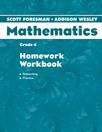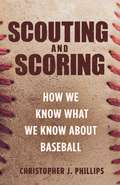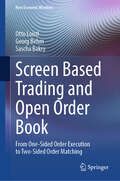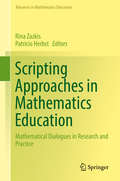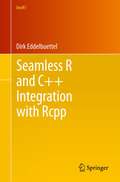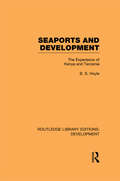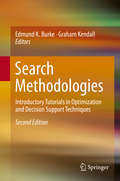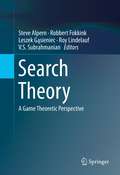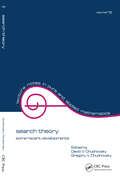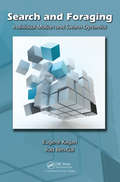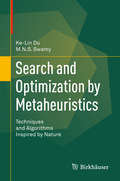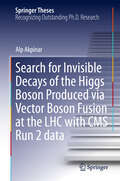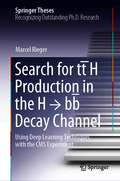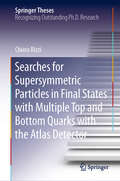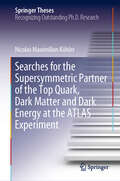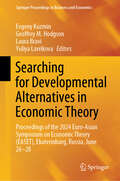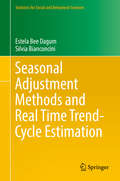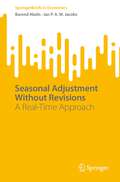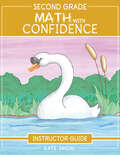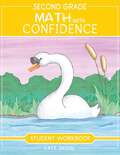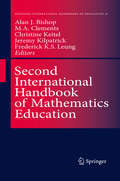- Table View
- List View
Scott Foresman-Addison Wesley Mathematics: Homework Workbook (Grade #4)
by Scott ForesmanGrade 4 homework workbook
Scouting and Scoring: How We Know What We Know about Baseball
by Christopher PhillipsAn in-depth look at the intersection of judgment and statistics in baseballScouting and scoring are considered fundamentally different ways of ascertaining value in baseball. Scouting seems to rely on experience and intuition, scoring on performance metrics and statistics. In Scouting and Scoring, Christopher Phillips rejects these simplistic divisions. He shows how both scouts and scorers rely on numbers, bureaucracy, trust, and human labor in order to make sound judgments about the value of baseball players.Tracing baseball’s story from the nineteenth century to today, Phillips explains that the sport was one of the earliest and most consequential fields for the introduction of numerical analysis. New technologies and methods of data collection were supposed to enable teams to quantify the drafting and managing of players—replacing scouting with scoring. But that’s not how things turned out. Over the decades, scouting and scoring started looking increasingly similar. Scouts expressed their judgments in highly formulaic ways, using numerical grades and scientific instruments to evaluate players. Scorers drew on moral judgments, depended on human labor to maintain and correct data, and designed bureaucratic systems to make statistics appear reliable. From the invention of official scorers and Statcast to the creation of the Major League Scouting Bureau, the history of baseball reveals the inextricable connections between human expertise and data science.A unique consideration of the role of quantitative measurement and human judgment, Scouting and Scoring provides an entirely fresh understanding of baseball by showing what the sport reveals about reliable knowledge in the modern world.
Screen Based Trading and Open Order Book: From One-Sided Order Execution to Two-Sided Order Matching (New Economic Windows)
by Otto Loistl Georg Behm Sascha BakryThis book explores screen-based trading with an open order book, where traders' decisions influence others in real time via that open order book. Modelling traders&’ actions using discrete choice, a method proven in other fields but new to finance, and the integration of discrete choice into a Markov Process, offers an innovative approach to understanding decision making under uncertainty. We call this combination "Doubly Stochastic Markov Process" (DSMP for short). The book is aimed at those interested in real market performance with traders&’ modelling based on behavioural expertise. Monitoring orders instead of prices creates a competitive advantage because the adjustment of prices requires prior adjustment of orders. Only the matching of orders generates transactions and prices. Efficient order management turns risky volatility into profits. The presentation of DSMP is preceded by an introductory overview of trading venues and concludes with an outlook on the increasing suitability of stochastic processes to implement the interactions of agents and to facilitate modelling the self-organisation of markets.
Scripting Approaches in Mathematics Education
by Rina Zazkis Patricio HerbstThis book shows how the practice of script writing can be used both as a pedagogical approach and as a research tool in mathematics education. It provides an opportunity for script-writers to articulate their mathematical arguments and/or their pedagogical approaches. It further provides researchers with a corpus of narratives that can be analyzed using a variety of theoretical perspectives. Various chapters argue for the use of dialogical method and highlight its benefits and special features. The chapters examine both "low tech" implementations as well as the use of a technological platform, LessonSketch. The chapters present results of and insights from several recent studies, which utilized scripting in mathematics education research and practice.
Seamless R and C++ Integration with Rcpp
by Dirk EddelbuettelRcpp is the glue that binds the power and versatility of R with the speed and efficiency of C++. With Rcpp, the transfer of data between R and C++ is nearly seamless, and high-performance statistical computing is finally accessible to most R users. Rcpp should be part of every statistician's toolbox. -- Michael Braun, MIT Sloan School of Management "Seamless R and C++ integration with Rcpp" is simply a wonderful book. For anyone who uses C/C++ and R, it is an indispensable resource. The writing is outstanding. A huge bonus is the section on applications. This section covers the matrix packages Armadillo and Eigen and the GNU Scientific Library as well as RInside which enables you to use R inside C++. These applications are what most of us need to know to really do scientific programming with R and C++. I love this book. -- Robert McCulloch, University of Chicago Booth School of Business Rcpp is now considered an essential package for anybody doing serious computational research using R. Dirk's book is an excellent companion and takes the reader from a gentle introduction to more advanced applications via numerous examples and efficiency enhancing gems. The book is packed with all you might have ever wanted to know about Rcpp, its cousins (RcppArmadillo, RcppEigen .etc.), modules, package development and sugar. Overall, this book is a must-have on your shelf. -- Sanjog Misra, UCLA Anderson School of Management The Rcpp package represents a major leap forward for scientific computations with R. With very few lines of C++ code, one has R's data structures readily at hand for further computations in C++. Hence, high-level numerical programming can be made in C++ almost as easily as in R, but often with a substantial speed gain. Dirk is a crucial person in these developments, and his book takes the reader from the first fragile steps on to using the full Rcpp machinery. A very recommended book! -- Søren Højsgaard, Department of Mathematical Sciences, Aalborg University, Denmark "Seamless R and C ++ Integration with Rcpp" provides the first comprehensive introduction to Rcpp. Rcpp has become the most widely-used language extension for R, and is deployed by over one-hundred different CRAN and BioConductor packages. Rcpp permits users to pass scalars, vectors, matrices, list or entire R objects back and forth between R and C++ with ease. This brings the depth of the R analysis framework together with the power, speed, and efficiency of C++. Dirk Eddelbuettel has been a contributor to CRAN for over a decade and maintains around twenty packages. He is the Debian/Ubuntu maintainer for R and other quantitative software, edits the CRAN Task Views for Finance and High-Performance Computing, is a co-founder of the annual R/Finance conference, and an editor of the Journal of Statistical Software. He holds a Ph.D. in Mathematical Economics from EHESS (Paris), and works in Chicago as a Senior Quantitative Analyst.
Seaports and Development: The Experience of Kenya and Tanzania (Routledge Library Editions: Development #69)
by B. S. HoyleThis book, originally published in 1983, demonstrates the importance of seaports in the growth of less-developed countries. The author focuses on the character of port activity within the context of transport systems and regional economic planning. General principles of port development are illustrated by detailed reference to one Third World port group, that of the Indian Ocean coasts of Kenya and Tanzania. The objective is not merely to illustrate the character of one specific group of ports, but to demonstrate methods of analysis and to underline the crucial role of ports in the development process.
Search Methodologies
by Edmund K. Burke Graham KendallThe first edition of Search Methodologies: Introductory Tutorials in Optimization and Decision Support Techniques was originally put together to offer a basic introduction to the various search and optimization techniques that students might need to use during their research, and this new edition continues this tradition. Search Methodologies has been expanded and brought completely up to date, including new chapters covering scatter search, GRASP, and very large neighborhood search. The chapter authors are drawn from across Computer Science and Operations Research and include some of the world's leading authorities in their field. The book provides useful guidelines for implementing the methods and frameworks described and offers valuable tutorials to students and researchers in the field. "As I embarked on the pleasant journey of reading through the chapters of this book, I became convinced that this is one of the best sources of introductory material on the search methodologies topic to be found. The book's subtitle, "Introductory Tutorials in Optimization and Decision Support Techniques", aptly describes its aim, and the editors and contributors to this volume have achieved this aim with remarkable success. The chapters in this book are exemplary in giving useful guidelines for implementing the methods and frameworks described. " Fred Glover, Leeds School of Business, University of Colorado Boulder, USA "[The book] aims to present a series of well written tutorials by the leading experts in their fields. Moreover, it does this by covering practically the whole possible range of topics in the discipline. It enables students and practitioners to study and appreciate the beauty and the power of some of the computational search techniques that are able to effectively navigate through search spaces that are sometimes inconceivably large. I am convinced that this second edition will build on the success of the first edition and that it will prove to be just as popular. " Jacek Blazewicz, Institute of Computing Science, Poznan University of Technology and Institute of Bioorganic Chemistry, Polish Academy of Sciences
Search Theory
by V. S. Subrahmanian Leszek Gąsieniec Steve Alpern Roy Lindelauf Robbert FokkinkSearch games and rendezvous problems have received growing attention in computer science within the past few years. Rendezvous problems emerge naturally, for instance, to optimize performance and convergence of mobile robots. This gives a new algorithmic point of view to the theory. Furthermore, modern topics such as the spreading of gossip or disease in social networks have lead to new challenging problems in search and rendezvous. Search Theory: A Game Theoretic Perspective introduces the first integrated approach to Search and Rendezvous from the perspectives of biologists, computer scientists and mathematicians. This contributed volume covers a wide range of topics including rendezvous problems and solutions, rendezvous on graphs, search games on biology, mobility in governed social networks, search and security, and more. Most chapters also include case studies or a survey, in addition to a chapter on the future direction of Search and Rendezvous research. This book targets researchers and practitioners working in computer science, mathematics and biology as a reference book. Advanced level students focused on these fields will also find this book valuable as a secondary text book or reference.
Search Theory: Some Recent Developments
by David V. Chudnovsky Gregory V. ChudnovskyOn the solution of an optimal search problem with an exponential detection function. Covers one- and two-sided detection problems by furnishing continuous and discret time strategies; examines two-sided search strategies with solutions in hide and seek games in many discrete and continuous bounded
Search and Foraging: Individual Motion and Swarm Dynamics
by Eugene Kagan Irad Ben-GalSince the start of modern computing, the studies of living organisms have inspired the progress in developing computers and intelligent machines. In particular, the methods of search and foraging are the benchmark problems for robotics and multi-agent systems. The highly developed theory of search and screening involves optimal search plans that ar
Search and Optimization by Metaheuristics
by Ke-Lin Du M. N. S. SwamyThis textbook provides a comprehensive introduction to nature-inspired metaheuristic methods for search and optimization, including the latest trends in evolutionary algorithms and other forms of natural computing. Over 100 different types of these methods are discussed in detail. The authors emphasize non-standard optimization problems and utilize a natural approach to the topic, moving from basic notions to more complex ones. An introductory chapter covers the necessary biological and mathematical backgrounds for understanding the main material. Subsequent chapters then explore almost all of the major metaheuristics for search and optimization created based on natural phenomena, including simulated annealing, recurrent neural networks, genetic algorithms and genetic programming, differential evolution, memetic algorithms, particle swarm optimization, artificial immune systems, ant colony optimization, tabu search and scatter search, bee and bacteria foraging algorithms, harmony search, biomolecular computing, quantum computing, and many others. General topics on dynamic, multimodal, constrained, and multiobjective optimizations are also described. Each chapter includes detailed flowcharts that illustrate specific algorithms and exercises that reinforce important topics. Introduced in the appendix are some benchmarks for the evaluation of metaheuristics. Search and Optimization by Metaheuristics is intended primarily as a textbook for graduate and advanced undergraduate students specializing in engineering and computer science. It will also serve as a valuable resource for scientists and researchers working in these areas, as well as those who are interested in search and optimization methods.
Search for Invisible Decays of the Higgs Boson Produced via Vector Boson Fusion at the LHC with CMS Run 2 data (Springer Theses)
by Alp AkpinarThis thesis reports the latest measurements on one of the leading dark matter searches conducted by the Compact Muon Solenoid (CMS) experiment at CERN, leading to some of the most stringent constraints on hypothesized interactions between the Higgs boson and dark matter. The thesis also includes further research about the future outlook of the experiment, including exploratory research on the adaptation of deep learning models in future dark matter analyses to improve analysis sensitivity, and the design of a new type of data processing hardware to be used in the next phase of the CMS experiment.
Search for tt̄H Production in the H → bb̅ Decay Channel: Using Deep Learning Techniques with the CMS Experiment (Springer Theses)
by Marcel RiegerIn 1964, a mechanism explaining the origin of particle masses was proposed by Robert Brout, François Englert, and Peter W. Higgs. 48 years later, in 2012, the so-called Higgs boson was discovered in proton-proton collisions recorded by experiments at the LHC. Since then, its ability to interact with quarks remained experimentally unconfirmed. This book presents a search for Higgs bosons produced in association with top quarks tt̄H in data recorded with the CMS detector in 2016. It focuses on Higgs boson decays into bottom quarks H → bb̅ and top quark pair decays involving at least one lepton. In this analysis, a multiclass classification approach using deep learning techniques was applied for the first time. In light of the dominant background contribution from tt̄ production, the developed method proved to achieve superior sensitivity with respect to existing techniques. In combination with searches in different decay channels, the presented work contributed to the first observations of tt̄H production and H → bb̅ decays.
Searches for Supersymmetric Particles in Final States with Multiple Top and Bottom Quarks with the Atlas Detector (Springer Theses)
by Chiara RizziThis PhD thesis documents two of the highest-profile searches for supersymmetry performed at the ATLAS experiment using up to 80/fb of proton-proton collision data at a center-of-mass energy of 13 TeV delivered by the Large Hadron Collider (LHC) during its Run 2 (2015-2018). The signals of interest feature a high multiplicity of jets originating from the hadronisation of b-quarks and large missing transverse momentum, which constitutes one of the most promising final state signatures for discovery of new phenomena at the LHC. The first search is focused on the strong production of a pair of gluinos, with each gluino decaying into a neutralino and a top-antitop-quark pair or a bottom-antibottom-quark pair. The second search targets the pair production of higgsinos, with each higgsino decaying into a gravitino and a Higgs boson, which in turn is required to decay into a bottom-antibottom-quark pair. Both searches employ state-of-the-art experimental techniques and analysis strategies at the LHC, resulting in some of the most restrictive bounds available to date on the masses of the gluino,neutralino, and higgsino in the context of the models explored.
Searches for the Supersymmetric Partner of the Top Quark, Dark Matter and Dark Energy at the ATLAS Experiment (Springer Theses)
by Nicolas Maximilian KöhlerAstrophysical observations implying the existence of Dark Matter and Dark Energy, which are not described by the Standard Model (SM) of particle physics, have led to extensions of the SM predicting new particles that could be directly produced at the Large Hadron Collider (LHC) at CERN. Based on 2015 and 2016 ATLAS proton-proton collision data, this thesis presents searches for the supersymmetric partner of the top quark, for Dark Matter, and for DarkEnergy, in signatures with jets and missing transverse energy.Muon detection is key to some of the most important LHC physics results, including the discovery of the Higgs boson and the measurement of its properties. The efficiency with which muons can be detected with the ATLAS detector is measured using Z boson decays. The performance of high-precision Monitored Drift Tube muon chambers under background rates similar to the ones expected for the High Luminosity-LHC is studied.
Searching for Developmental Alternatives in Economic Theory: Proceedings of the 2024 Euro-Asian Symposium on Economic Theory (EASET), Ekaterinburg, Russia, June 26-28 (Springer Proceedings in Business and Economics)
by Geoffrey M. Hodgson Evgeny Kuzmin Yuliya Lavrikova Laura BraviThis book discusses the conceptual foundations of mainstream and political economy and offers alternative directions for the development of theoretical economics. Presenting selected papers from the Euro-Asian Symposium on Economic Theory, held by the Institute of Economics of the Ural Branch of the Russian Academy of Sciences (Ekaterinburg, Russia) on June 26-28, 2024, this book examines the ways in which economic theory helps solve problem such as the expansion of new technologies, inequality, environmental justice, globalization, regionalization, and a polycentric world. It delves into the evolution and resilience of industrial ecosystems, investigate the fundamental nature of money, the complexities of achieving justice and efficiency in economic development are addressed, examining income disparities, the convergence of economies, and social aspects within economic mechanisms. The contributions featured in this book offer a synthesis of theoretical models and empirical analyses, bridging the gap between academic inquiry and practical application. This collection is a valuable resource for researchers, policymakers, and practitioners seeking innovative solutions to navigate the complexities of today&’s economic systems.
Searching for Whitopia: An Improbable Journey to the Heart of White America
by Rich BenjaminAs America becomes more and more racially diverse, Rich Benjamin noticed a phenomenon: Some communities were actually getting less multicultural. So he got out a map, found the whitest towns in the USA--and moved in.A journalist-adventurer, Benjamin packed his bags and embarked on a 26,909-mile journey throughout the heart of white America, to some of the fastest-growing and whitest locales in our nation. Benjamin calls these enclaves "Whitopias." In this groundbreaking book, he shares what he learned as a black man in Whitopia. Benjamin's journey to unlock the mysteries of Whitopia took him from a three-day white separatist retreat with links to Aryan Nations in North Idaho to exurban mega-churches down South, and many points in between. A compelling raconteur, bon vivant, and scholar, Benjamin reveals what Whitopias are like and explores the urgent social and political implications of this startling phenomenon. Benjamin's groundbreaking study is one of few to have illuminated in advance the social and political forces propelling the rise of Donald Trump. After all, Trump carried 94 percent of America's Whitopian counties. And he won a median 67 percent of the vote in Whitopia compared to 46 percent of the vote nationwide.Leaving behind speculation or sensationalism, Benjamin explores the future of whiteness and race in an increasingly multicultural nation.
Sears and Zemansky's: University Physics, Volume 2
by Roger A. Freedman A. Lewis Ford Hugh D. YoungUniversity Physics Volume 2 (Chapers 21-37), 13/e continues to set the benchmark for clarity and rigor combined with effective teaching and research-based innovation. University Physics is known for its uniquely broad, deep, and thoughtful set of worked examples-key tools for developing both physical understanding and problem-solving skills. The Thirteenth Edition revises all the Examples and Problem-Solving Strategies to be more concise and direct while maintaining the Twelfth Edition's consistent, structured approach and strong focus on modeling as well as math. To help students tackle challenging as well as routine problems, the Thirteenth Edition adds Bridging Problems to each chapter, which pose a difficult, multiconcept problem and provide a skeleton solution guide in the form of questions and hints. The text's rich problem sets-developed and refined over six decades-are upgraded to include larger numbers of problems that are biomedically oriented or require calculus. The problem-set revision is driven by detailed student-performance data gathered nationally through MasteringPhysics®, making it possible to fine-tune the reliability, effectiveness, and difficulty of individual problems.
Seasonal Adjustment Methods and Real Time Trend-Cycle Estimation
by Estela Bee Dagum Silvia BianconciniThis book explores widely used seasonaladjustment methods and recent developments in real time trend-cycle estimation. It discusses in detail the properties and limitations of X12ARIMA, TRAMO-SEATSand STAMP - the main seasonal adjustment methods used by statistical agencies. Several real-world cases illustrate eachmethod and real data examples can be followed throughout the text. Thetrend-cycle estimation is presented using nonparametric techniques based onmoving averages, linear filters and reproducing kernel Hilbert spaces, takingrecent advances into account. The book provides a systematical treatment ofresults that to date have been scattered throughout the literature. Seasonal adjustment and real timetrend-cycle prediction play an essential part at all levels of activity inmodern economies. They are used by governments to counteract cyclicalrecessions, by central banks to control inflation, by decision makers forbetter modeling and planning and by hospitals, manufacturers, builders,transportation, and consumers in general to decide on appropriate action. This book appeals to practitioners ingovernment institutions, finance and business, macroeconomists, and other professionalswho use economic data as well as academic researchers in time series analysis,seasonal adjustment methods, filtering and signal extraction. It is also usefulfor graduate and final-year undergraduate courses in econometrics and timeseries with a good understanding of linear regression and matrix algebra, aswell as ARIMA modelling.
Seasonal Adjustment Without Revisions: A Real-Time Approach (SpringerBriefs in Economics)
by Barend Abeln Jan P. JacobsSeasonality in economic time series can "obscure" movements of other components in a series that are operationally more important for economic and econometric analyses. In practice, one often prefers to work with seasonally adjusted data to assess the current state of the economy and its future course. This book presents a seasonal adjustment program called CAMPLET, an acronym of its tuning parameters, which consists of a simple adaptive procedure to extract the seasonal and the non-seasonal component from an observed series. Once this process is carried out, there will be no need to revise these components at a later stage when new observations become available. The authors describe the main features of CAMPLET, evaluate the outcomes of CAMPLET and X-13ARIMA-SEATS in a controlled simulation framework using a variety of data generating processes, and illustrate CAMPLET and X-13ARIMA-SEATS with three time series: US non-farm payroll employment, operational income of Ahold and real GDP in the Netherlands. Furthermore they show how CAMPLET performs under the COVID-19 crisis, and its attractiveness in dealing with daily data. This book appeals to scholars and students of econometrics and statistics, interested in the application of statistical methods for empirical economic modeling.
Seasonality and Microcredit
by Abu S. ShonchoyThe mismatch between credit repayments and income seasonality can create serious distortions. However, typically Micro-Finance Institutes (MFIs) do not provide any adjustments due to the income seasonality. For instance in Northern Bangladesh, Income and consumption downfalls during the time of post-Aman rice plantation seasons are quite regular phenomenon which is locally known as "Monga". Poor landless agricultural wage laborers suffer the most due to this seasonality and usually they face difficulty to smooth their consumptions. As a result, it is extremely difficult to arrange the regular weekly loan repayments of the micro-credit, which they have taken during the productive part of the year. Using field experiments through RCTs in Northern Bangladesh, we randomly assigned seasonality adjusted flexible micro-credits and traditional rigid micro-credit to different borrowing groups. Examining the repayment behavior of the borrowers in the context of geographical classifications and loan designs; employing both survey and experimental methods, this study allows us to see the consequences of flexible loan repayment rules during the lean periods, and how they affect both MFIs and participating borrowers. The findings of this study have important policy implications for MFIs and policy-makers of the developing countries.
Second Grade Math With Confidence Instructor Guide (Math with Confidence #7)
by Kate SnowA scripted, open-and-go program that will have you teaching math confidently--even if you’ve never taught math before. From popular math educator Kate Snow, this easy-to-use program will give parents the tools they need to teach Math with Confidence—even if they’ve never taught math before. Short, engaging, and hands-on lessons will help children develop a strong understanding of Second Grade math, step by step. reading, writing, and comparing numbers to 1000 adding and subtracting 2- and 3-digit numbers solving addition and subtraction word problems telling time, counting money, and measuring length reading graphs, identifying 2-D and 3-D shapes, and understanding simple fractions Children will develop both strong number sense and a positive attitude toward math with fun activities like Pretend Restaurant, Measurement Tag, and Fraction Bump. All you’ll need are this Instructor Guide, the Student Workbook, and simple household items (like play money, base-ten blocks, a clock, and a ruler) to make math come alive for children. Short, hands-on, and developmentally-appropriate lessons Games and pretend activities make math fun Easy to use, with clear directions and explanatory notes Delightful (and optional) weekly enrichment lessons, with picture book recommendations and real-life math extension activities Memory work and daily review to ensure children retain what they’ve learned and master essential skills
Second Grade Math With Confidence Student Workbook (Math With Confidence Ser.)
by Kate SnowA colorful, engaging workbook to reinforce and practice the skills taught in the Second Grade Math with Confidence Instructor Guide. Simple and straightforward workbook pages give children practice with new concepts and provide daily reviews of previously learned skills. Short, simple pages give children written practice without tiring small hands Daily review helps children retain what they have learned. All answers are provided in the Instructor’s Guide for easy correcting Colorful, whimsical illustrations Age Range: 7-8 Grade Range: Second Grade full-color illustrations on every page.
Second International Handbook of Mathematics Education (Springer International Handbooks of Education #10)
by Alan J. BishopALAN 1. BISHOP The first International Handbook on Mathematics Education was published by Kluwer Academic Publishers in 1996. However, most of the writing for that handbook was done in 1995 and generally reflected the main research and development foci prior to 1994. There were four sections, 36 chapters, and some 150 people contributed to the final volume either as author, reviewer, editor, or critical friend. The task was a monumental one, attempting to cover the major research and practice developments in the international field of mathematics education as it appeared to the contributors in 1995. Inevitably there were certain omissions, some developments were only starting to emerge, and some literatures were only sketchy and speculative. However that Handbook has had to be reprinted three times, so it clearly fulfilled a need and I personally hope that it lived up to what I wrote in its Introduction: The Handbook thus attempts not merely to present a description of the international 'state-of-the-field', but also to offer synthetic and reflective overviews on the different directions being taken by the field, on the gaps existing in our present knowledge, on the current problems being faced, and on the future possibilities for development. (Bishop et aI. , 1996) Since that time there has been even more activity in our field, and now seems a good time to take stock again, to reflect on what has happened since 1995, and to create a second Handbook with the same overall goals.
Second International Handbook on the Demography of Sexuality (International Handbooks of Population #14)
by Amanda K. Baumle Zelma Oyarvide TuthillA decade after the publication of the first International Handbook on the Demography of Sexuality, there have been fundamental shifts in how we measure sexual and gender identities and the breadth of available population-level sexuality data. The chapters in this second edition of this handbook provide guidance on methodological approaches involved in studying population sexuality, as well as insight into the ways that sexuality shapes key demographic outcomes. Chapters examine how we measure sexual identities and behaviors on surveys, sexuality changes across the life course, international perspectives on sexual behaviors and identities, and the ways that sexual identities shape families, labor market experiences, and health outcomes. Despite these developments, we still know relatively little about key demographic questions related to fertility and migration for sexual minorities, as well as about understudied topics of sexuality that fall outside of risk-focused analyses. In particular, much of our understanding of sexuality has been motivated by controlling the spread of sexually transmitted infections or adolescent pregnancies, rather than understanding motivations for sexual interactions, such as pleasure. Accordingly, although the research set forth in this book provides insight into existing knowledge of sexual behavior and of sexual minority populations, the chapters also point researchers and policymakers toward needed areas of research and data collection.
